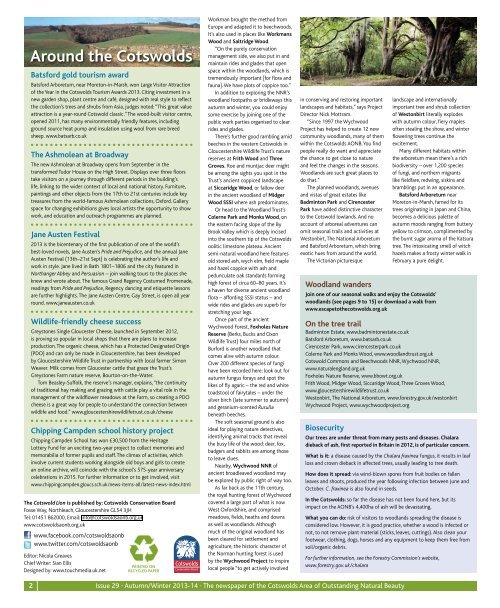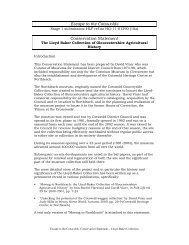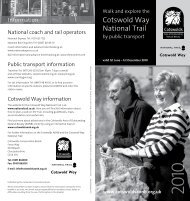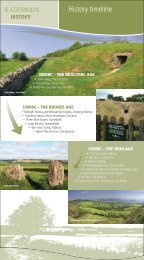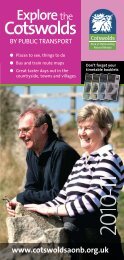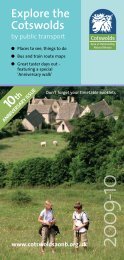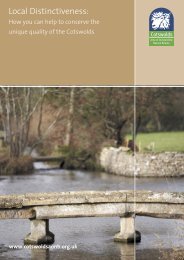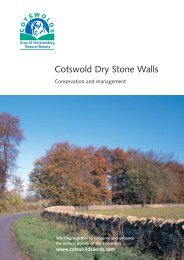Autumn/Winter Cotswold Lion - Cotswolds Area of Outstanding ...
Autumn/Winter Cotswold Lion - Cotswolds Area of Outstanding ...
Autumn/Winter Cotswold Lion - Cotswolds Area of Outstanding ...
Create successful ePaper yourself
Turn your PDF publications into a flip-book with our unique Google optimized e-Paper software.
Around the <strong>Cotswold</strong>sBatsford gold tourism awardBatsford Arboretum, near Moreton-in-Marsh, won Large Visitor Attraction<strong>of</strong> the Year in the <strong>Cotswold</strong>s Tourism Awards 2013. Citing investment in anew garden shop, plant centre and café, designed with real style to reflectthe collection’s trees and shrubs from Asia, judges noted: “This great valueattraction is a year-round <strong>Cotswold</strong> classic.” The wood-built visitor centre,opened 2011, has many environmentally friendly features, includingground source heat pump and insulation using wool from rare breedsheep. www.batsarb.co.ukThe Ashmolean at BroadwayThe new Ashmolean at Broadway opens from September in thetransformed Tudor House on the High Street. Displays over three floorstake visitors on a journey through different periods in the building’slife, linking to the wider context <strong>of</strong> local and national history. Furniture,paintings and other objects from the 17th to 21st centuries include keytreasures from the world-famous Ashmolean collections, Oxford. Galleryspace for changing exhibitions gives local artists the opportunity to showwork, and education and outreach programmes are planned.Jane Austen Festival2013 is the bicentenary <strong>of</strong> the first publication <strong>of</strong> one <strong>of</strong> the world’sbest-loved novels, Jane Austen’s Pride and Prejudice, and the annual JaneAusten Festival (13th–21st Sept) is celebrating the author’s life andwork in style. Jane lived in Bath 1801–1806 and the city featured inNorthanger Abbey and Persuasion – join walking tours to the places sheknew and wrote about. The famous Grand Regency Costumed Promenade,readings from Pride and Prejudice, Regency dancing and etiquette lessonsare further highlights. The Jane Austen Centre, Gay Street, is open all yearround. www.janeausten.co.ukWildlife-friendly cheese successGreystones Single Gloucester Cheese, launched in September 2012,is proving so popular in local shops that there are plans to increaseproduction. The organic cheese, which has a Protected Designated Origin(PDO) and can only be made in Gloucestershire, has been developedby Gloucestershire Wildlife Trust in partnership with local farmer SimonWeaver. Milk comes from Gloucester cattle that graze the Trust’sGreystones Farm nature reserve, Bourton-on-the-Water.Tom Beasley-Suffolk, the reserve’s manager, explains, “the continuity<strong>of</strong> traditional hay making and grazing with cattle play a vital role in themanagement <strong>of</strong> the wildflower meadows at the Farm, so creating a PDOcheese is a great way for people to understand the connection betweenwildlife and food.” www.gloucestershirewildlifetrust.co.uk/cheeseChipping Campden school history projectChipping Campden School has won £30,500 from the HeritageLottery Fund for an exciting two-year project to collect memories andmemorabilia <strong>of</strong> former pupils and staff. The climax <strong>of</strong> activities, whichinvolve current students working alongside old boys and girls to createan online archive, will coincide with the school’s 575-year anniversarycelebrations in 2015. For further information or to get involved, visitwww.chippingcampden.gloucs.sch.uk/news-items-all/latest-news-index.htmlThe <strong>Cotswold</strong> <strong>Lion</strong> is published by: <strong>Cotswold</strong>s Conservation BoardFosse Way, Northleach, Gloucestershire GL54 3JHTel: 01451 862000, Email: info@cotswoldsaonb.org.ukwww.cotswoldsaonb.org.ukwww.facebook.com/cotswoldsaonbwww.twitter.com/cotswoldsaonbEditor: Nicola GreavesChief Writer: Sian EllisDesigned by: www.touchmedia.uk.netPRINTED ONRECYCLED PAPERWorkman brought the method fromEurope and adapted it to beechwoods.It’s also used in places like WorkmansWood and Saltridge Wood.“On the purely conservationmanagement side, we also put in andmaintain rides and glades that openspace within the woodlands, which istremendously important [for flora andfauna]. We have plots <strong>of</strong> coppice too.”In addition to exploring the NNR’swoodland footpaths or bridleways thisautumn and winter, you could enjoysome exercise by joining one <strong>of</strong> thepublic work parties organised to clearrides and glades.There’s further good rambling amidbeeches in the western <strong>Cotswold</strong>s inGloucestershire Wildlife Trust’s naturereserves at Frith Wood and ThreeGroves. Roe and muntjac deer mightbe among the sights you spot in theTrust’s ancient coppiced landscapeat Siccaridge Wood, or fallow deerin the ancient woodland <strong>of</strong> MidgerWood SSSI where ash predominates.Or head to the Woodland Trust’sColerne Park and Monks Wood, onthe eastern facing slope <strong>of</strong> the ByBrook Valley which is deeply incisedinto the southern tip <strong>of</strong> the <strong>Cotswold</strong>soolitic limestone plateau. Ancientsemi-natural woodland here featuresold stored ash, wych elm, field mapleand hazel coppice with ash andpedunculate oak standards forminghigh forest <strong>of</strong> circa 60–80 years. It’sa haven for diverse ancient woodlandflora – affording SSSI status – andwide rides and glades are superb forstretching your legs.Once part <strong>of</strong> the ancientWychwood Forest, Foxholes NatureReserve (Berks, Bucks and OxonWildlife Trust) four miles north <strong>of</strong>Burford is another woodland thatcomes alive with autumn colour.Over 200 different species <strong>of</strong> fungihave been recorded here: look out forautumn fungus forays and spot thelikes <strong>of</strong> fly agaric – the red and whitetoadstool <strong>of</strong> fairytales – under thesilver birch (late summer to autumn)and geranium-scented Rusullabeneath beeches.The s<strong>of</strong>t seasonal ground is alsoideal for playing nature detectives,identifying animal tracks that revealthe busy life <strong>of</strong> the wood: deer, fox,badgers and rabbits are among thoseto leave clues.Nearby, Wychwood NNR <strong>of</strong>ancient broadleaved woodland maybe explored by public right <strong>of</strong> way too.As far back as the 11th century,the royal hunting forest <strong>of</strong> Wychwoodcovered a large part <strong>of</strong> what is nowWest Oxfordshire, and comprisedmeadows, fields, heaths and downsas well as woodlands. Althoughmuch <strong>of</strong> the original woodland hasbeen cleared for settlement andagriculture, the historic character <strong>of</strong>the Norman hunting forest is usedby the Wychwood Project to inspirelocal people “to get actively involvedin conserving and restoring importantlandscapes and habitats,” says ProjectDirector Nick Mottram.“Since 1997 the WychwoodProject has helped to create 12 newcommunity woodlands, many <strong>of</strong> themwithin the <strong>Cotswold</strong>s AONB. You findpeople really do want and appreciatethe chance to get close to natureand feel the changes in the seasons.Woodlands are such great places todo that.”The planned woodlands, avenuesand vistas <strong>of</strong> great estates likeBadminton Park and CirencesterPark have added distinctive characterto the <strong>Cotswold</strong> lowlands. And noaccount <strong>of</strong> arboreal adventures canomit seasonal trails and activities atWestonbirt, The National Arboretumand Batsford Arboretum, which bringexotic hues from around the world.The Victorian picturesqueWoodland wandersJoin one <strong>of</strong> our seasonal walks and enjoy the <strong>Cotswold</strong>s’woodlands (see pages 9 to 15) or download a walk fromwww.escapetothecotswolds.org.ukOn the tree trailBadminton Estate, www.badmintonestate.co.ukBatsford Arboretum, www.batsarb.co.ukCirencester Park, www.cirencesterpark.co.ukColerne Park and Monks Wood, www.woodlandtrust.org.uk<strong>Cotswold</strong> Commons and Beechwoods NNR, Wychwood NNR,www.naturalengland.org.ukFoxholes Nature Reserve, www.bbowt.org.ukFrith Wood, Midger Wood, Siccaridge Wood, Three Groves Wood,www.gloucestershirewildlifetrust.co.ukWestonbirt, The National Arboretum, www.forestry.gov.uk/westonbirtWychwood Project, www.wychwoodproject.orgBiosecuritylandscape and internationallyimportant tree and shrub collection<strong>of</strong> Westonbirt literally explodeswith autumn colour, fiery maples<strong>of</strong>ten stealing the show, and winterflowering trees continue theexcitement.Many different habitats withinthe arboretum mean there’s a richbiodiversity – over 1,200 species<strong>of</strong> fungi, and northern migrantslike fieldfare, redwing, siskins andbramblings put in an appearance.Batsford Arboretum nearMoreton-in-Marsh, famed for itstrees originating in Japan and China,becomes a delicious palette <strong>of</strong>autumn moods ranging from butteryyellow to crimson, complimented bythe burnt sugar aroma <strong>of</strong> the Katsuratree. The intoxicating smell <strong>of</strong> witchhazels makes a frosty winter walk inFebruary a pure delight.Our trees are under threat from many pests and diseases. Chalaradieback <strong>of</strong> ash, first reported in Britain in 2012, is <strong>of</strong> particular concern.What is it: a disease caused by the Chalara fraxinea fungus, it results in leafloss and crown dieback in affected trees, usually leading to tree death.How does it spread: via wind-blown spores from fruit bodies on fallenleaves and shoots, produced the year following infection between June andOctober. C. fraxinea is also found in seeds.In the <strong>Cotswold</strong>s: so far the disease has not been found here, but itsimpact on the AONB’s 4,400ha <strong>of</strong> ash will be devastating.What you can do: risk <strong>of</strong> visitors to woodlands spreading the disease isconsidered low. However, it is good practice, whether a wood is infected ornot, to not remove plant material (sticks, leaves, cuttings). Also clean yourfootwear, clothing, dogs, horses and any equipment to keep them free fromsoil/organic debris.For further information, see the Forestry Commission’s website,www.forestry.gov.uk/chalara2Issue 29


